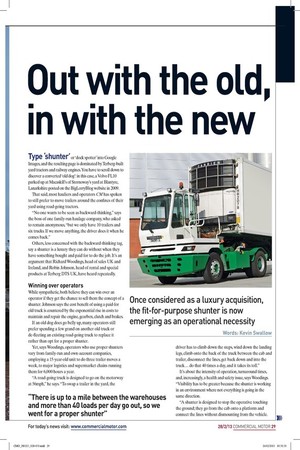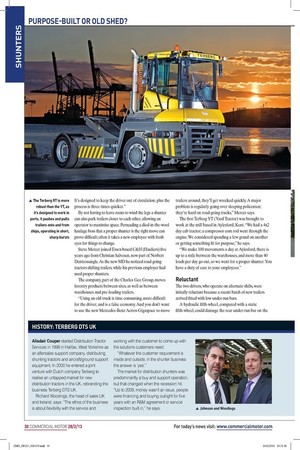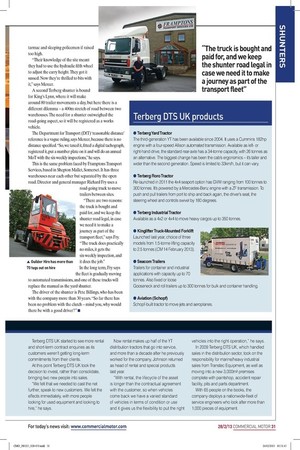Out with the old, in with the new
Page 20

Page 21

Page 22

If you've noticed an error in this article please click here to report it so we can fix it.
Once considered as a luxury acquisition, the fit-for-purpose shunter is now emerging as an operational necessity Words: Kevin Swallow Type 'shunter' or 'dock spotter' into Google Images, and the resulting page is dominated by Terberg-built yard tractors and railway engines. You have to scroll down to discover a converted 'old dog': in this case, a Volvo FL10 parked up at Macaskill's of Stornoway's yard at Blantyre, Lanarkshire posted on the BigLorryBlog website in 2009.
That said, most hauliers and operators CM has spoken to still prefer to move trailers around the confines of their yard using road-going tractors.
"No one wants to be seen as backward-thinking," says the boss of one family-run haulage company, who asked to remain anonymous, "but we only have 10 trailers and six trucks. If we move anything, the driver does it when he comes back."
Others, less concerned with the backward-thinking tag, say a shunter is a luxury they can do without when they have something bought and paid for to do the job. It's an argument that Richard Woodings, head of sales UK and Ireland, and Robin Johnson, head of rental and special products at Terberg DTS UK, have heard repeatedly.
Winning over operators While sympathetic, both believe they can win over an operator if they get the chance to sell them the concept of a shunter. Johnson says the cost benefit of using a paid-for old truck is countered by the exponential rise in costs to maintain and repair the engine, gearbox, clutch and brakes.
If an old dog does go belly up, many operators still prefer spending a few grand on another old truck or de-fleeting an existing road-going truck to replace it rather than opt for a proper shunter.
Yet, says Woodings, operators who use proper shunters vary from family-run and own-account companies, employing a 15-year-old unit to do three trailer moves a week, to major logistics and supermarket chains running them for 6,000 hours a year.
"A road-going truck is designed to go on the motorway at 56mph," he says. "To swap a trailer in the yard, the driver has to climb down the steps, wind down the landing legs, climb onto the back of the truck between the cab and trailer, disconnect the lines, get back down and into the truck... do that 40 times a day, and it takes its toll."
It's about the intensity of operation, turnaround times, and, increasingly, a health and safety issue, says Woodings. "Visibility has to be greater because the shunter is working in an environment where not everything is going in the same direction.
"A shunter is designed to stop the operative touching the ground; they go from the cab onto a platform and connect the lines without dismounting from the vehicle.
It's designed to keep the driver out of circulation, plus the process is three times quicker."
By not having to leave room to wind the legs a shunter can also park trailers closer to each other, allowing an operator to maximise space. Persuading a died-in-the-wool haulage boss that a proper shunter is the right move can prove difficult; often it takes a new employee with fresh eyes for things to change.
Steve Mercer joined Essex-based C&H (Hauliers) five years ago from Christian Salvesen, now part of Norbert Dentressangle. As the new MD he noticed road-going tractors shifting trailers, while his previous employer had used proper shouters.
The company, part of the Charles Gee Group, moves forestry products between sites, as well as between warehouses and pre-loading trailers.
"Using an old truck is time consuming, more difficult for the driver, and is a false economy. And you don't want to use the new Mercedes-Benz Actros Gigasp ace to move trailers around, they'll get wrecked quickly. A major problem is regularly going over sleeping policemen; they're hard on road-going trucks," Mercer says.
The first Terberg YT (Yard Tractor) was brought to work at the mill based in Aylesford, Kent. "We had a 4x2 day cab tractor; a compressor com rod went through the engine. We considered spending a few grand on another or getting something fit for purpose," he says.
"We make 100 movements a day at Aylesford, there is up to a mile between the warehouses, and more than 40 loads per day go out, so we went for a proper shunter. You have a duty of care to your employees."
Reluctant The two drivers, who operate on alternate shifts, were initially reluctant because a recent batch of new trailers arrived fitted with low under-run bars.
A hydraulic fifth-wheel, compared with a static fifth-wheel, could damage the rear under-run bar on the tarmac and sleeping policemen if raised too high.
"Their knowledge of the site meant they had to use the hydraulic fifth wheel to adjust the carry height. They got it sussed. Now they're thrilled to bits with it," says Mercer.
A second Terberg shunter is bound for King's Lynn, where it will make around 80 trailer movements a day, but here there is a different dilemma — a 400m stretch of road between two warehouses. The need for a shunter outweighed the road-going aspect, so it will be registered as a works vehicle.
The Department for Transport (DfT) 'reasonable distance' reference is a vague ruling, says Mercer, because there is no distance specified. "So, we taxed it, fitted a digital tachograph, registered it, put a number plate on it and will do an annual MoT with the six-weekly inspections," he says.
This is the same problem faced by Framptons Transport Services, based in Shepton Mallet, Somerset. It has three warehouses near each other but separated by the open road. Director and general manager Richard Fry uses a road-going truck to move trailers between sites.
"There are two reasons: the truck is bought and paid for, and we keep the shunter road legal, in case we need it to make a journey as part of the transport fleet," says Fry. "The truck does practically no miles, it gets the six-weekly inspection, and A Guilder Hire has more than it does the job."
70 tugs out on hire In the long term, Fry says the fleet is gradually moving to automated transmissions, and one of these trucks will replace the manual as the yard shunter.
The driver of the shunter is Pete Billings, who has been with the company more than 30 years. "So far there has been no problem with the clutch — mind you, why would there be with a good driver?" • HISTORY: TERBERG DTS UK Alisdair Couper started Distribution Tractor Services in 1998 in Halifax, West Yorkshire as an aftersales support company, distributing shunting tractors and aircraft/ground support equipment. In 2000 he entered a joint venture with Dutch company Terberg to realise an untapped market for new distribution tractors in the UK, rebranding the business Terberg DTS UK.
Richard Woodings, the head of sales UK and Ireland, says: "The ethos of the business is about flexibility with the service and working with the customer to come up with the solutions customers need.
"Whatever the customer requirement is inside and outside, in the shunter business the answer is 'yes': The market for distribution shunters was predominantly a buy and support operation, but that changed when the recession hit. "Up to 2008, money wasn't an issue, people were financing and buying outright for five years with an R&M agreement or service inspection built in," he says.
Terberg DTS UK started to see more rental and short-term contract enquiries as its customers weren't getting long-term commitments from their clients.
At this point Terberg DTS UK took the decision to invest, rather than consolidate, bringing two new people into sales.
"We felt that we needed to cast the net further, speak to new customers. We felt the effects immediately, with more people looking for used equipment and looking to hire," he says.
Now rental makes up half of the YT distribution tractors that go into service, and more than a decade after he previously worked for the company, Johnson returned as head of rental and special products last year.
"With rental, the lifecycle of the asset is longer than the contractual agreement with the customer, so when vehicles come back we have a varied standard of vehicles in terms of condition or use and it gives us the flexibility to put the right vehicles into the right operation," he says.
In 2009 Terberg DTS UK, which handled sales in the distribution sector, took on the responsibility for marine/heavy industrial sales from Transtec Equipment, as well as moving into a new 3,000m2 premises complete with paintshop, accident repair facility, pits and parts department.
With 65 people on the books, the company deploys a nationwide-fleet of service engineers who look after more than 1,000 pieces of equipment.
Terberg DTS UK products • Terberg Yard Tractor The third-generation YT has been available since 2004. It uses a Cummins 182hp engine with a four-speed Allison automated transmission. Available as leftor right-hand drive, the standard rear-axle has a 34-tonne capacity, with 26 tonnes as an alternative. The biggest change has been the cab's ergonomics — it's taller and wider than the second generation. Speed is limited to 33km/h, but it can vary.
• Terberg Roro Tractor Re-launched in 2011 the 4x4 seaport option has GVW ranging from 100 tonnes to 300 tonnes. It's powered by a Mercedes-Benz engine with a ZF transmission. To push and pull trailers from port to ship and back again, the driver's seat, the steering wheel and controls swivel by 180 degrees.
• Terberg Industrial Tractor Available as a 4x2 or 4x4 to move heavy cargos up to 350 tonnes.
• Kinglifter Truck-Mounted Forklift Launched last year, choice of three models from 1.5-tonne lifting capacity to 2.5 tonnes (CM 14 February 2013).
• Seacom Trailers Trailers for container and industrial applications with capacity up to 70 tonnes. Also fixed or loose Gooseneck and roll trailers up to 300 tonnes for bulk and container handling.
• Aviation (Schopf) Schopf-built tractor to move jets and aeroplanes.







































